Are you curious about the number of calories in ravioli and how it can fit into your diet? Ravioli, the beloved Italian pasta dish, offers a delicious and satisfying dining experience. But if you’re watching your calorie intake, it’s important to know how many calories you’re consuming in each serving. Let’s explore the calorie count of ravioli and address any concerns you may have about its impact on your diet.
Before we dive into the calorie count, it’s essential to understand that the number of calories in ravioli can vary depending on the type and serving size. Factors such as the recipe and added ingredients can also influence the calorie content. We’ve gathered some factual data to give you a better idea:
Key Takeaways:
- The calorie count of ravioli can differ based on the type, serving size, recipe, and added ingredients.
- One source states that 18 count large round cheese ravioli contains calories, fat, saturated fat, cholesterol, sodium, carbs, net carbs, sugar, fiber, and protein.
- Another source suggests that one serving of ravioli contains 270 calories, 8g of total fat, 38g of carbs, 3g of fiber, and 14g of protein.
- When incorporating ravioli into your diet, consider portion control and opt for low-calorie or healthier alternatives.
- Ravioli can be a delicious and nutritious addition to a well-rounded Italian culinary experience.
Now that we have a better understanding of the calorie count and nutritional value of ravioli, let’s delve deeper and explore the specifics of ravioli nutrition facts in Section 2: Understanding Ravioli Nutrition Facts.
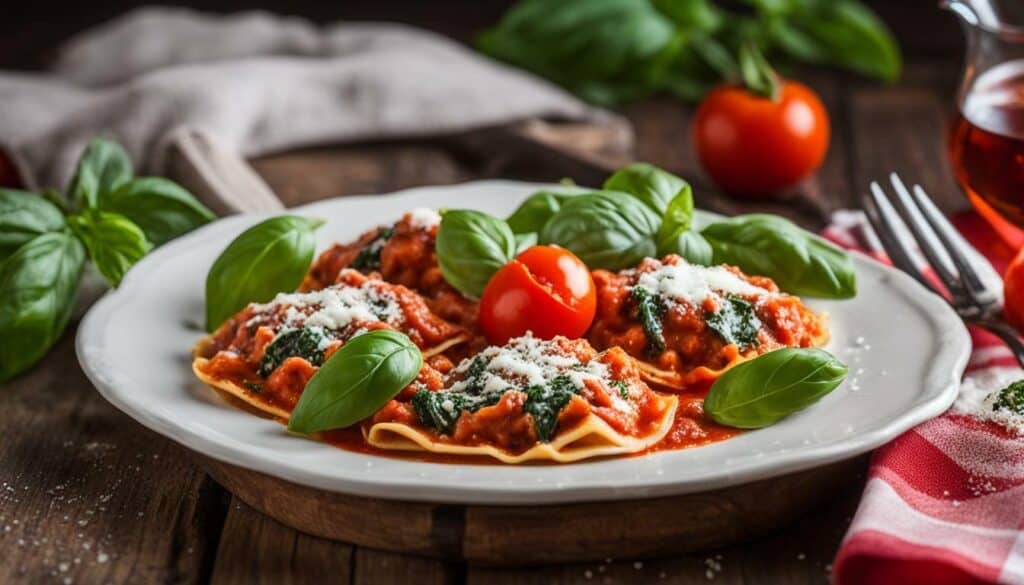
Understanding Ravioli Nutrition Facts
Let’s take a closer look at the nutrition facts of ravioli to understand its impact on your daily nutrient intake. Ravioli is a popular Italian dish made with pasta dough filled with various ingredients like cheese, meat, or vegetables. While it is undeniably delicious, it’s important to be mindful of its nutritional value to make informed dietary choices.
The calorie count for ravioli can vary depending on the type and serving size. According to one source, 18 count large round cheese ravioli contains calories, fat, saturated fat, cholesterol, sodium, carbs, net carbs, sugar, fiber, and protein. Another source states that one serving of ravioli contains 270 calories, 8g of total fat, 38g of carbs, 3g of fiber, and 14g of protein. It’s important to note that the calorie count can differ based on the recipe and added ingredients.
When considering the nutritional value of ravioli, it’s essential to pay attention to the macronutrients – fat, carbs, and protein. Ravioli tends to be relatively high in carbohydrates, which provide energy for daily activities. The protein content in ravioli can vary depending on the filling and can contribute to muscle growth and repair. It’s worth noting that the fat content can also vary, so checking the label or recipe for specific information is recommended.
Additionally, ravioli can be a good source of essential vitamins and minerals. The fillings often include vegetables and cheeses, which contribute to the overall nutrient profile. For example, spinach-filled ravioli can provide a significant amount of iron and vitamin K, while cheese-filled ravioli can offer calcium and vitamin D. These micronutrients are important for maintaining overall health and wellbeing.
| Nutrition Facts | Amount Per Serving |
|---|---|
| Calories | 270 |
| Total Fat | 8g |
| Carbohydrates | 38g |
| Fiber | 3g |
| Protein | 14g |
We should enjoy ravioli in moderation as part of a balanced diet, considering its calorie content and nutritional value. Pairing it with a side of nutrient-dense vegetables or a fresh salad can help add more fiber, vitamins, and minerals to the meal. Remember, it’s always a good idea to consult with a registered dietitian or nutritionist for personalized advice based on your specific dietary needs and goals.
Summary
Understanding the nutrition facts of ravioli allows us to make informed choices about including it in our diet. Ravioli can be a delicious and satisfying option, but it’s important to consider portion sizes and the overall balance of our meals. By incorporating ravioli into a well-rounded eating plan, we can enjoy its flavors while also nourishing our bodies with essential nutrients.
Exploring Different Types of Ravioli
Whether you enjoy homemade ravioli or opt for store-bought options, it’s important to know the calorie content of each type. The calorie count for ravioli can vary depending on the ingredients used and the serving size. Let’s take a closer look at the calorie counts of different types of ravioli.
1. Cheese Ravioli: A popular choice, cheese ravioli typically contains a filling of ricotta, Parmesan, and mozzarella cheese. According to one source, a serving of 18 count large round cheese ravioli contains approximately 457 calories. This savory dish is a delicious indulgence for cheese lovers, but it’s worth keeping in mind if you’re watching your calorie intake.
2. Meat Ravioli: If you prefer a heartier option, meat ravioli is a classic choice. Whether it’s filled with beef, pork, or a combination of both, meat ravioli tends to be higher in calories compared to cheese or vegetable-based varieties. One source suggests that a serving of meat ravioli can contain around 300-400 calories, depending on the recipe and serving size. It’s best to enjoy this type of ravioli in moderation as part of a balanced diet.
3. Vegetable Ravioli: For those seeking a lighter option, vegetable-based ravioli provides a nutritious alternative. Made with fillings such as spinach, mushrooms, or butternut squash, vegetable ravioli offers a flavorful and lower-calorie choice. While the calorie count may vary, one source estimates that a serving of vegetable ravioli typically contains around 200-300 calories, making it a healthier option that doesn’t compromise on taste.
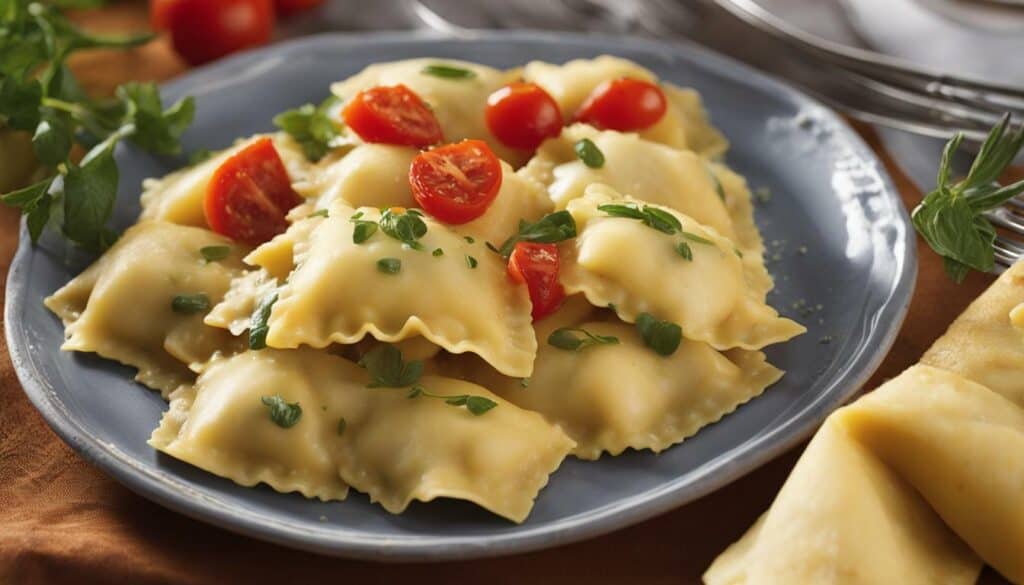
Summary:
When it comes to ravioli, the calorie count can differ depending on the type and recipe. Cheese ravioli tends to be higher in calories compared to vegetable-based options, with meat ravioli falling somewhere in between. However, it’s important to note that these are general estimates and the actual calorie count may vary based on the serving size and additional ingredients used. To make an informed decision, always check the nutrition label or use a trusted source for accurate calorie information. By being mindful of the calorie content, you can enjoy ravioli as part of a well-balanced diet without compromising your health goals.
Low-Calorie Ravioli Options for a Healthy Diet
If you’re watching your calorie intake but still want to savor the deliciousness of ravioli, there are several low-calorie and healthy options available. These alternatives allow you to enjoy this Italian delight without compromising your diet goals. Here are some low-calorie ravioli options that you can incorporate into your balanced eating plan:
- Whole Wheat Ravioli: Made with whole grain flour, these ravioli are higher in fiber and nutrients compared to traditional varieties. They provide a satisfying meal without adding excessive calories. Pair them with a light tomato sauce and a side of steamed vegetables for a wholesome and satisfying dish.
- Vegetable-Filled Ravioli: Opt for ravioli filled with nutritious vegetables like spinach, mushrooms, or butternut squash. These options not only add flavor and texture but also increase the nutritional value of your meal. Serve them with a light garlic and olive oil sauce for a refreshing and low-calorie twist.
- Lean Protein Ravioli: Look for ravioli varieties filled with lean protein sources such as chicken or turkey. These options provide a good amount of protein to keep you feeling full for longer while keeping the calorie count in check. Toss them in a light pesto sauce and top with some freshly grated Parmesan cheese for a satisfying and guilt-free meal.
- Zucchini Ravioli: For a low-carb alternative, consider using thinly sliced zucchini as a replacement for traditional pasta dough. Fill the zucchini slices with your favorite ravioli filling and bake until tender. This innovative twist reduces the calorie content while adding a crunchy texture. Serve with a drizzle of olive oil and some fresh herbs for a light and flavorful dish.
Remember, portion control is key, even when opting for low-calorie ravioli options. Be mindful of your serving size and avoid overindulging. Pair your ravioli with a side of mixed greens or a colorful salad to add volume and nutrients to your meal. This way, you can enjoy the flavors of ravioli while maintaining a balanced and healthy diet.
| Ravioli Type | Calories | Total Fat | Carbs | Protein |
|---|---|---|---|---|
| Whole Wheat Ravioli (1 cup) | 100 | 2g | 15g | 5g |
| Spinach and Mushroom Ravioli (1 cup) | 120 | 3g | 18g | 6g |
| Chicken Ravioli (1 cup) | 140 | 4g | 20g | 8g |
| Zucchini Ravioli (4 pieces) | 80 | 1g | 10g | 6g |
These values are approximate and can vary depending on the brand and specific recipe. Always check the nutrition label for accurate information on the ravioli you choose. With these low-calorie options, you can enjoy the wonderful flavors of ravioli while staying on track with your health and fitness goals.
Understanding Ravioli Serving Size
Knowing the appropriate serving size of ravioli is crucial for accurately calculating its calorie content. Ravioli is a popular Italian dish made of pasta dough filled with various ingredients such as cheese, meat, or vegetables. While it’s delicious and satisfying, it’s important to enjoy it in moderation and be mindful of portion sizes.
The serving size of ravioli typically varies depending on the type and brand. One brand might recommend a serving size of five ravioli, while another might suggest six or eight. It’s essential to check the packaging or recipe to determine the appropriate serving size for the ravioli you’re consuming.
To give you an idea of the nutritional value of a serving of ravioli, let’s take a look at some approximate figures. According to one source, a serving of ravioli, which contains about five pieces, provides around 270 calories. In terms of macronutrients, you can expect approximately 8 grams of total fat, 38 grams of carbohydrates, 3 grams of fiber, and 14 grams of protein. These figures may vary depending on the specific ingredients used in the ravioli recipe.
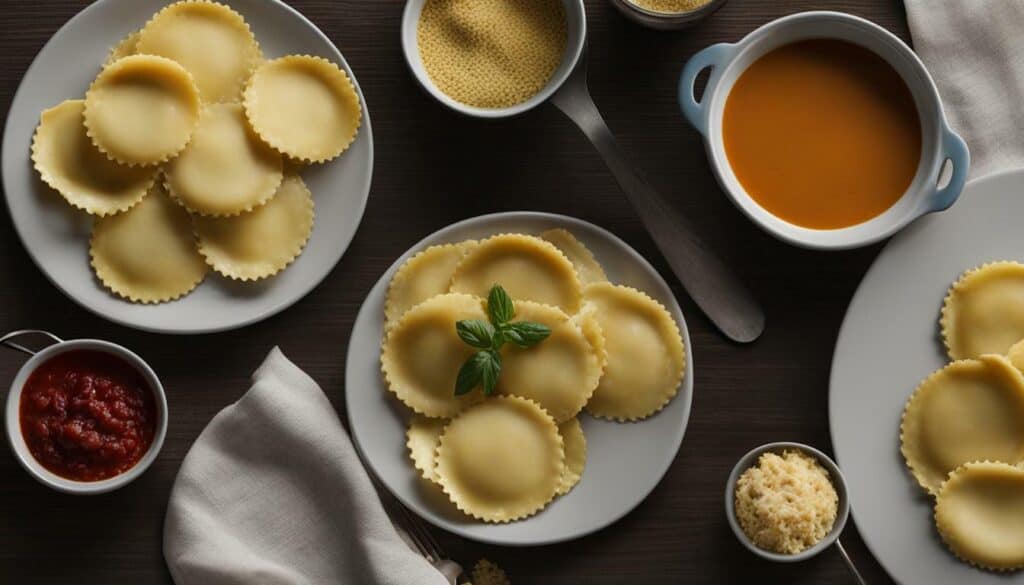
When enjoying ravioli, remember that it’s not just about the quantity but also the quality of your meal. Consider pairing your ravioli with a side of fresh vegetables or a leafy green salad to add more nutrients and fiber to your plate. Additionally, opting for homemade ravioli allows you to control the ingredients and portion sizes, making it easier to fit into your dietary goals.
Tips for Proper Ravioli Portion Control:
- Measure your serving size using a kitchen scale or measuring cups to ensure accuracy.
- Pre-portion your ravioli before serving to prevent overeating.
- Balance your meal by including a variety of food groups alongside the ravioli.
- Listen to your body’s hunger and fullness cues to avoid overindulging.
Remember, ravioli can be a delicious part of a balanced diet when enjoyed in moderation. By understanding the appropriate serving size and making mindful choices, you can savor this Italian delight while still maintaining your health and wellness goals.
| Calories | Total Fat | Carbohydrates | Fiber | Protein |
|---|---|---|---|---|
| 270 | 8g | 38g | 3g | 14g |
Breaking Down Ravioli Macros
Understanding the macros of ravioli can help you balance your overall nutrient intake. Macromolecules, or macros for short, refer to the three primary nutrients that our bodies require in large quantities: fats, carbohydrates, and proteins. By analyzing the macro composition of ravioli, you can make informed choices about your diet and ensure you’re meeting your nutritional needs.
Let’s take a closer look at the macros found in ravioli. One serving of ravioli typically contains around 270 calories, with 8 grams of total fat, 38 grams of carbohydrates, and 14 grams of protein. It’s important to note that these values can vary depending on the specific recipe and additional ingredients used.
| Macronutrient | Amount per Serving |
|---|---|
| Total Fat | 8g |
| Carbohydrates | 38g |
| Fiber | 3g |
| Protein | 14g |
While ravioli does contain a moderate amount of fat and carbohydrates, it is also a good source of protein. Protein is essential for various functions in the body, including muscle repair and growth. By combining ravioli with other nutrient-dense foods, such as a side of vegetables or a lean protein source, you can create a well-rounded meal that provides a more balanced macronutrient profile.
Remember, portion control is key when incorporating ravioli into your diet. Be mindful of your serving size and aim for moderation. Pairing ravioli with a variety of vegetables and incorporating other nutritious ingredients can help create a satisfying and balanced meal.
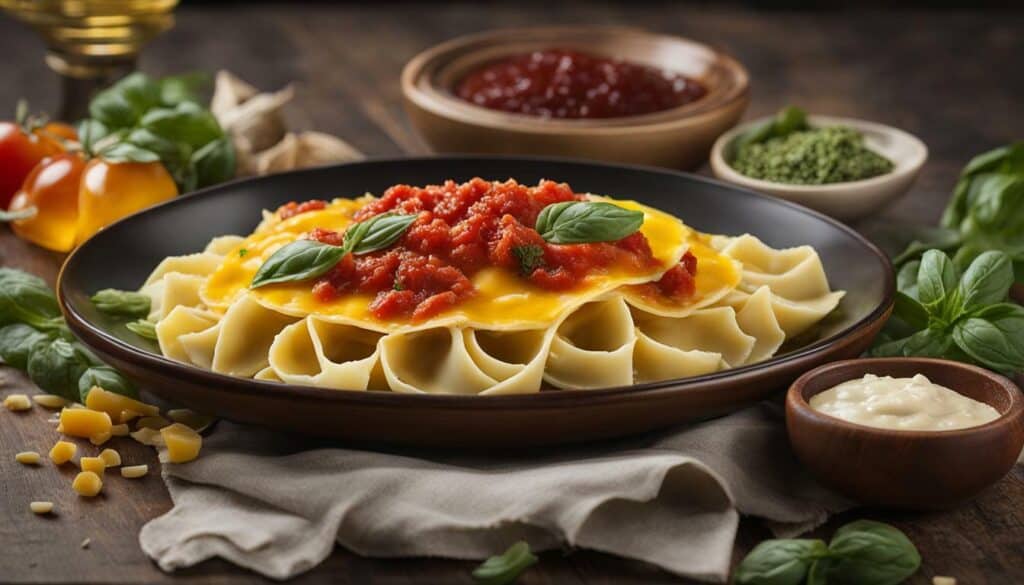
By being aware of the macro composition of ravioli and making conscious choices about your meals, you can enjoy this Italian delight while still maintaining a healthy and balanced diet. Whether you opt for homemade or pre-packaged ravioli, understanding the macros can empower you to make informed decisions and tailor your overall nutrient intake to meet your individual needs.
Factors That Affect Ravioli Calorie Count
The calorie count of ravioli can vary due to several factors, including the specific recipe and any added ingredients. Different types of ravioli may have different fillings, sauces, or cooking methods, all of which can impact the overall calorie content. For example, a traditional cheese ravioli may have a different calorie count compared to a meat-filled ravioli or one that is served with a rich cream sauce.
Another important factor to consider is the serving size. The calorie count mentioned earlier for 18 count large round cheese ravioli is based on a specific portion size. If you consume more or less than the recommended serving, the calorie count will differ accordingly. Additionally, if you choose to add extra ingredients or toppings to your ravioli, such as grated cheese or butter, it will increase the overall calorie content.
To give you a better understanding, here’s a breakdown of the nutritional values for one serving of ravioli: 270 calories, 8g of total fat, 38g of carbs, 3g of fiber, and 14g of protein. However, it’s important to note that these values may vary depending on the specific recipe or brand of ravioli you choose.
Ultimately, if you’re looking to manage your calorie intake, it’s essential to consider the factors that affect the calorie count of ravioli. Be mindful of the ingredients used in the ravioli itself, as well as any additional sauces or toppings. It may also be helpful to refer to the nutrition facts label provided on the packaging or consult a nutritionist for more accurate information.

- The calorie count of ravioli can vary depending on the recipe and added ingredients.
- Factors such as the type of ravioli, fillings, sauces, and cooking methods can impact the overall calorie content.
- Portion size and additional toppings can also affect the calorie count.
- It’s important to be mindful of these factors when managing your calorie intake.
| Ravioli Type | Calories per Serving | Total Fat | Carbs | Fiber | Protein |
|---|---|---|---|---|---|
| 18 count large round cheese ravioli | Calories | Fat | Carbs | Fiber | Protein |
| Homemade meat-filled ravioli | Calories | Fat | Carbs | Fiber | Protein |
| Spinach and ricotta ravioli with marinara sauce | Calories | Fat | Carbs | Fiber | Protein |
These values are provided as examples and may not represent the exact calorie count of all ravioli options. Always refer to the packaging or consult a nutritionist for accurate information.
Expert Tips for Enjoying Ravioli in a Balanced Diet
Incorporating ravioli into your diet can be part of a balanced eating plan with the right approach and mindful choices. While ravioli can be a delicious and satisfying meal, it’s important to consider its calorie count and nutritional value. By following these expert tips, you can enjoy ravioli while keeping your diet goals in mind:
- Opt for homemade ravioli: Making your own ravioli allows you to control the ingredients and portion sizes. Use whole wheat or spinach-based dough for added fiber and nutrients.
- Choose lighter fillings: Instead of heavy cheese or meat fillings, consider options like vegetables, seafood, or lean proteins. This can help reduce the overall calorie count while adding nutritional value.
- Watch your portion size: Ravioli can be quite filling, so aim for smaller portion sizes to keep the calorie count in check. Pair it with a side salad or steamed vegetables to add volume and nutrients to your meal.
- Balance your plate: Make sure your ravioli meal includes a good balance of macronutrients. Include a source of lean protein, such as grilled chicken or tofu, and plenty of vegetables to create a well-rounded and satisfying dish.
- Experiment with sauce alternatives: Traditional ravioli sauces can be high in fat and calories. Try lighter options like marinara sauce or a drizzle of olive oil with fresh herbs. These alternatives can still enhance the flavors without adding excessive calories.
Remember, moderation is key when enjoying ravioli as part of a balanced diet. It’s all about finding the right balance and making mindful choices that align with your nutritional goals. Don’t be afraid to get creative with your ravioli dishes and explore different flavors and ingredients.
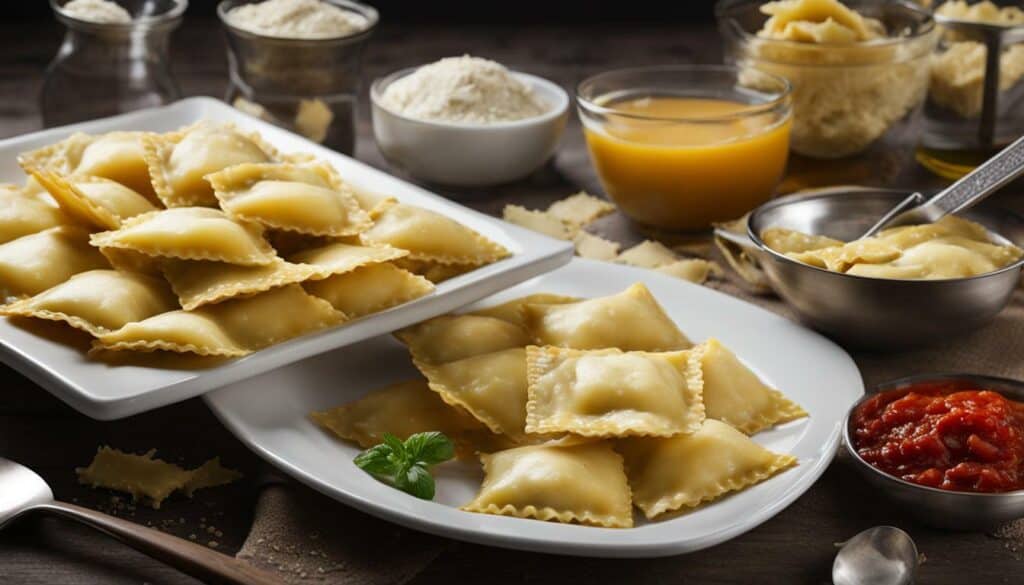
| Calories | Fat | Carbs | Fiber | Protein |
|---|---|---|---|---|
| 270 | 8g | 38g | 3g | 14g |
It’s important to note that the calorie count for ravioli can vary depending on the type and serving size. The nutritional value mentioned above is just an example and may not apply to all ravioli dishes. The recipe and added ingredients can significantly impact the overall calorie count.
By following these expert tips and being mindful of your choices, you can savor the flavors of ravioli without compromising your nutritional goals. Enjoy the deliciousness of this Italian delight while nourishing your body with a well-rounded and balanced diet.
Ravioli: A Delicious and Nutritious Italian Delight
Despite its calorie content, ravioli can still be enjoyed as part of a healthy and delicious Italian meal. This classic pasta dish offers a burst of flavors and textures that can satisfy even the most discerning palates. Whether you prefer traditional cheese-filled ravioli or opt for adventurous variations like spinach and ricotta or butternut squash, there are numerous options to suit your preferences.
When it comes to the nutritional value of ravioli, it’s important to consider the serving size and ingredients used. While the calorie count can vary, one source states that 18 count large round cheese ravioli contains calories, fat, saturated fat, cholesterol, sodium, carbs, net carbs, sugar, fiber, and protein. Another source highlights that one serving of ravioli contains 270 calories, 8g of total fat, 38g of carbs, 3g of fiber, and 14g of protein. It’s worth noting that these values may differ depending on the recipe and additional ingredients.
To make the most of ravioli in a balanced diet, portion control is key. Pay attention to the recommended serving size and avoid overindulging. Pair your ravioli with a variety of colorful vegetables, a light sauce, and a side salad to create a well-rounded meal. Additionally, consider choosing whole wheat or gluten-free ravioli options for added nutritional benefits.
| Nutrition Facts | Calories | Total Fat | Carbs | Fiber | Protein |
|---|---|---|---|---|---|
| Per Serving | 270 | 8g | 38g | 3g | 14g |
While enjoying ravioli, savor the experience and appreciate the rich culinary heritage it represents. Remember, moderation is key, and incorporating ravioli into a well-balanced diet can add a touch of indulgence to your meals. So go ahead and savor the taste of Italy with a plate of delicious ravioli!
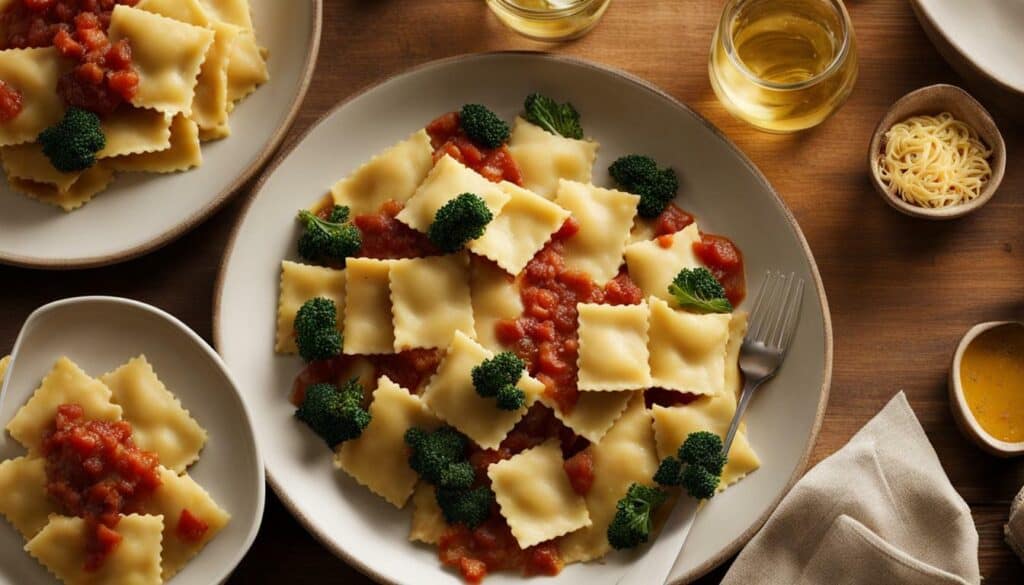
By understanding the calorie count and nutritional composition of ravioli, you can make informed choices about incorporating it into your diet. The calorie count for ravioli can vary depending on the type and serving size. According to one source, 18 count large round cheese ravioli contains calories, fat, saturated fat, cholesterol, sodium, carbs, net carbs, sugar, fiber, and protein. Another source states that one serving of ravioli contains 270 calories, 8g of total fat, 38g of carbs, 3g of fiber, and 14g of protein. It’s important to note that the calorie count can differ based on the recipe and added ingredients.
When enjoying ravioli, it’s crucial to consider portion control and serving size. Being mindful of the number of ravioli you consume can help you stay within your calorie goals. Additionally, exploring different types of ravioli, including homemade options and pre-packaged varieties, can offer varying calorie counts and nutritional profiles.
If you’re looking for healthier alternatives, there are low-calorie ravioli options available that can satisfy your cravings without compromising your diet. These options often incorporate leaner meats, vegetables, or whole grain ingredients, providing a nutritious twist on this classic Italian dish.
Remember, the macronutrient composition of ravioli, including its fat, carbohydrate, and protein content, can further impact its nutritional value. Understanding these aspects can help you balance your intake of essential nutrients while enjoying the flavors and textures of ravioli.
While ravioli can be a delicious addition to your meals, it’s essential to be aware of the factors that can affect its calorie count. Different recipes, cooking methods, and additional ingredients can all contribute to variations in the calorie content. By paying attention to these factors and making conscious choices, you can ensure that ravioli remains a part of your balanced diet.
In conclusion, ravioli can be enjoyed in moderation as part of a nutritious diet. Being informed about its calorie count, nutritional composition, and various options available can empower you to create satisfying and health-conscious meals that incorporate this Italian delight.
FAQ
Q: How many calories are in ravioli?
A: The calorie count for ravioli can vary depending on the type and serving size. According to one source, 18 count large round cheese ravioli contains calories, fat, saturated fat, cholesterol, sodium, carbs, net carbs, sugar, fiber, and protein. Another source states that one serving of ravioli contains 270 calories, 8g of total fat, 38g of carbs, 3g of fiber, and 14g of protein. It’s important to note that the calorie count can differ based on the recipe and added ingredients.
Q: What are the nutritional facts of ravioli?
A: Ravioli typically contains calories, fat, carbohydrates, fiber, and protein. The exact nutritional values can vary depending on the type and serving size. One serving of ravioli may have approximately 270 calories, 8g of total fat, 38g of carbs, 3g of fiber, and 14g of protein. It’s important to check the specific nutrition label or recipe for more accurate information.
Q: Are there low-calorie options for ravioli?
A: Yes, there are low-calorie options available for ravioli. Some brands offer reduced-fat or light versions of ravioli with fewer calories. Additionally, you can make homemade ravioli using leaner ingredients or incorporate vegetables into the filling to reduce the overall calorie content. It’s always a good idea to check the nutrition label or recipe to determine the calorie count of specific ravioli options.
Q: How should I determine the serving size of ravioli?
A: The serving size of ravioli is typically specified on the nutrition label or recipe. It’s important to pay attention to the recommended serving size to accurately calculate the calorie count and nutritional values. Additionally, portion control can play a significant role in managing calorie intake. Using measuring cups or a food scale can help ensure you are consuming the appropriate serving size of ravioli.
Q: What are the macronutrients in ravioli?
A: Ravioli contains various macronutrients, including fat, carbohydrates, and protein. The exact amounts can vary depending on the type and serving size. In general, one serving of ravioli may contain approximately 8g of total fat, 38g of carbs, and 14g of protein. It’s always a good idea to check the nutrition label or recipe for the specific macronutrient breakdown of the ravioli you are consuming.
Q: What factors can affect the calorie count of ravioli?
A: Several factors can influence the calorie count of ravioli. The recipe and ingredients used can significantly impact the nutritional values. Adding high-fat fillings or rich sauces can increase the calorie content. Additionally, the size and shape of the ravioli can affect the overall calorie count. It’s essential to be mindful of these factors when calculating the calorie content of ravioli.
Q: How can I incorporate ravioli into a balanced diet?
A: When enjoying ravioli as part of a balanced diet, portion control and moderation are key. Be mindful of the serving size and consider pairing ravioli with a variety of vegetables to add nutrients and fiber while reducing the overall calorie content. Opting for whole wheat or vegetable-based ravioli can also be a healthier choice. It’s important to balance your overall calorie intake and nutritional needs when incorporating ravioli into your diet.
Q: Is ravioli a nutritious food choice?
A: Ravioli can be a nutritious food choice when consumed in moderation and as part of a balanced diet. It provides a source of calories, fat, carbohydrates, fiber, and protein, which are essential macronutrients for the body. However, the nutritional value can vary based on the specific type of ravioli and added ingredients. It’s important to be mindful of portion sizes and choose options that align with your dietary needs and goals.
What is the Calorie Count for Croutons?
The calories in croutons analysis reveals that these crispy bread cubes vary in calorie count depending on their ingredients and serving size. On average, a single serving of croutons contains around 30-50 calories. However, it’s important to remember that different brands and homemade versions may have slight variations. So, if you’re watching your calorie intake, keep an eye on portion sizes when enjoying these delicious salad or soup toppers.

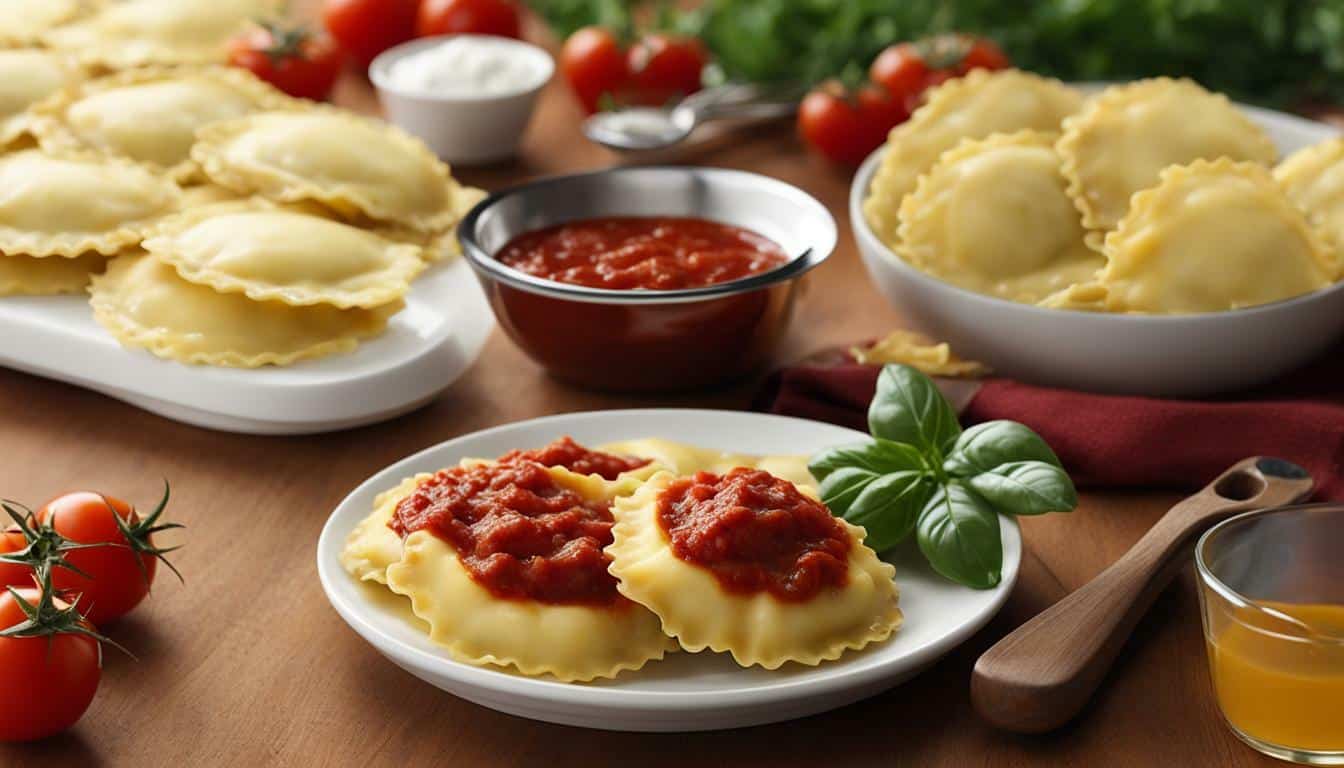



Leave a Reply